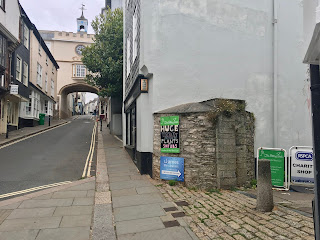Having listed most of my personal vinyl collection I thought I'd share my experience and some tips on how best to list your own records on the Discogs database. It's well worthwhile not just as a record (sic) of your personal collection but it gives you a valuation (based on recent sales in the Discogs marketplace) and apparently this can be used for insurance purposes too (the collection is downloadable in a spreadsheet format). Trading your records then becomes a doddle also.
So here goes with my suggestions:
- Best search using catalogue number (more accurate). This is recommended as there are often several bands with same or similar names. Album titles (unless particularly bizarre) can throw up many results.
- Generally there is no need to add spaces between numbers and letters as displayed on the product. Dashes, stars and backslashes maybe more important (but not always it seems). Discogs seems to search on basis of alphanumeric strings.
- Barcodes (usually printed on the back of the cover) started appearing on albums from the early 80s and can be a quick way of finding your record. Best to write the complete code including the first and last numbers outside of the barcode itself. The Discogs app (for phones and tablets) has a barcode scanner that can save time. However, multiple similar search results often appear. Imho it's still quicker to use the catalogue number as usually these are shorter than the barcode numbers anyway and sometimes half a dozen characters is all that is needed.
- If several similar entries appear in the search results select (all versions) if available, as the top entry might not actually be the correct one and it’s best to use the following process to locate your copy.
- If no ‘all versions’ you might be lucky and hit on the exact listing you need, follow it through to the Release page and check all the details carefully (see below for more info).
- If this isn’t your copy or if there are multiple results appearing then best to just click on any one so it goes through to that release page, then click on the ‘All versions of this release’ (top right)
- All versions brings you to the Master Release page - click ‘🔍Find My Version’ (sometimes this is off screen below all the track listings so scroll down as necessary).
- Best to work mainly from the physical record itself now.
- Narrow down specifics - i.e. in Format select Vinyl if a record.
- Check Country of manufacture if written on the label (or sleeve). If it’s an unusual country (i.e. outside the US, UK massive music industries) you might find there are only a few pressings. On the other hand you may find multiple pressings from the same country (sometimes running up into the hundreds for very popular releases) in this case the matrices are where you should start to narrow it down.
- Label (Record companies) are not always helpful imho as there are often releases on similar labels in different countries and the label info can be doubled up or confusing.
- Dates might relate to the original release year and / or actual pressing date, although often a reissue might use the original date. so not conclusive..
- Now check the matrix in the lock groove, time to get that magnifying glass out and some bright or natural light! Add as much info into the ‘Search Releases’ box as possible and see if it picks up your copy.
- Usually there will be the catalogue number, followed by the side indicator (A, B etc) and then some other numbers like 3U-1-2. These all help to identify a pressing. Adding more of the matrix will help to identify your copy although sometimes the reverse is true and reducing the suffixes i.e. -1-1-2 down can be more helpful at least initially.
- The listed matrices (scroll right down to the bottom of the listing) can often help to identify your particular issue.
- If someone else has already listed that particular copy in the database but your copy has slightly different matrices - you can add your ‘variant’ if you like, but there’s a different set of rules for submissions and you need to be quite sure that it hasn’t already been added elsewhere). Sometimes even one character difference or even apparently the same info (see label designs below) can mean you are looking at the wrong release.
- There are many German pressings marked as R/S Alsdorf in the lock groove. A shorter ‘Alsdorf’ then the following number to find a release seems to work.
- Sometimes the Mastering House (and /or engineer) will have a credit, look for Townhouse, Strawberry, Bilbo etc. You probably might not need this extra info but some pressings are defined by where they were mastered.
- Occasionally there will be humorous phrases written in the groove which again can help identify a first press for example. Have found a few I never knew were there!
- If not finding your copy at all then try working backwards reducing info to just the basic catalogue number until you have a selection of results to work on.
- Sometimes there will be multiple copies that look almost identical and seem to have the same details. If some are obviously from different countries (if you’re unable to work out where it was manufactured) these can be disregarded if the locations are too unusual (i.e. you’re pretty sure it didn’t come from Israel) but you’ll probably have to click on a few to see if they match up to the copy you have.
- Sometimes the matrix number can give false positives, i.e. a copy appears that is obviously not the one you have. Try checking the B side version and adding other numbers that might also be etched into the groove. Even the mastering house might help.
- Another tactic I use is to look at the images, specifically the actual disc label pictures as the differences in layout, text information, and even colour, can help to definitively track down your copy. Particularly the text around the edge of the label, does it have 1,2 or 3 lines, some in a different language, and how far round the edge does it reach (look at other design elements to line up with). Look for missing or extra logos, particularly foreign rights societies (LC, BIEM etc) generally if it looks different to the copy in your hands it is another listing you are looking for.
- Sometimes the info is identical across several copies but they are differentiated by cover (sleeve) finish, e.g embossed, textured, lacquered finishes. Check for these words in the top descriptions next to the picture of the artwork.
- Coloured, picture disk and special finish options should also appear here.
- Often even after finding similar (or sometimes the same) matrices it is still best to check the label designs if there are multiple copies to identify the correct copy.
Condition grading - my 2p worth
M (Mint) = New, untouched, probably even sealed copy
NM- (Near Mint) = As new, almost totally perfect
VG+ (Very Good plus) = Has been played but generally in great condition, no obvious scratches, scuffs or sticky marks
All the ones below this you can pretty much make up depending on how you feel the vinyl looks / sounds
As far as covers go VG+ seems a good grading if it’s not got any creases, rips, tears, sticker damage, ring wear or cat attack.
Again downgrade from here as necessary.
If you sell anything and say it’s M or NM and it really isn’t as good as I’ve mentioned above, expect moans! VG+ is good compromise even if the record seems almost good enough to be the level up, customer can always be happier if it’s better than expected!








